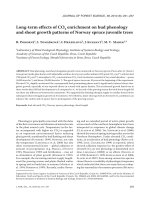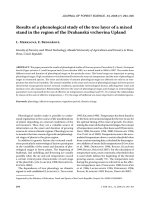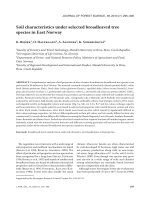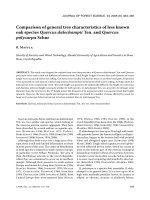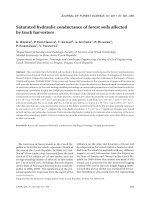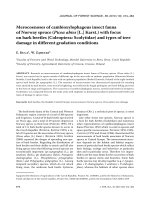Báo cáo lâm nghiệp: "Whole tree hydraulic conductance and water loss regulation in Quercus during drought: evidence for stomatal control of embolism?" doc
Bạn đang xem bản rút gọn của tài liệu. Xem và tải ngay bản đầy đủ của tài liệu tại đây (603.33 KB, 10 trang )
Original
article
Whole
tree
hydraulic
conductance
and
water
loss
regulation
in
Quercus
during
drought:
evidence
for
stomatal
control
of
embolism?
H Cochard,
N
Bréda,
A
Granier
Unité
d’écophysiologie
forestière,
Centre
de
Nancy,
Inra,
54280
Champenoux,
France
(Received
2
January
1995;
accepted
19
June
1995)
Summary —
The
water
relations
of
30-year-old
Quercus
petraea
were
studied
for
three
consecutive
growing
seasons.
Whole
tree
specific
hydraulic
conductances
(gL)
were
computed
from
sap
flow
den-
sities
(dF)/leaf
water
potential
(Ψ
leaf
)
relationships.
gL
was
clearly
reduced
with
the
development
of
the
drought.
The
decrease
of
gL
with Ψ
predawn
was
of
an
exponential
type,
ie,
high
variations
of
gL
were
found
whereas
Ψ
predawn
remained
high
and
constant.
These
early
variations
of
gL
were
most
probably
located
in
the
soil-root
compartment
of
the
SPAC
because
no
loss
of
hydraulic
conductivity
due
to
xylem
embolism
was
detected
in
the
crown
of
the
trees.
Although
gL
was
reduced,
Ψ
midday
remained
nearly
constant
and
above
-3
MPa
throughout
the
drought
period
because
dF
midday
was
also
signifi-
cantly
reduced.
As
a
consequence,
a
good
linear
relation
was
found
between
dF
midday
and
gL.
Xylem
embolism
significantly
developed
in
the
petioles
and
twigs
of
Q petraea
when Ψ
midday
became
less
than
-
3 MPa.
We
argue
that,
because
of
changes
in
gL,
Q petraea
progressively
adjusted
its
water
loss
throughout
the
drought
development
with
the
effect
of
maintaining Ψ
midday
above
the
cavitation
thresh-
old.
It
is
shown
that
if
no
water
loss
regulation
had
occurred,
considerable
tensions
would
have
devel-
oped
in
the
crown
of
these
trees
with
predictable
branch
mortality
due
to
runaway
embolism.
Quercus
petraea
/
drought
/
water
relation
/
embolism
/
hydraulic
conductance
Resumé —
Conductance
hydraulique
totale
et
régulation
des
pertes
en
eau
chez
Quercus
en
période
de
sécheresse :
preuve
d’un
contrôle
stomatique
du
développement
de
l’embolie ?
Les
relations
hydriques
de chênes
sessiles
agés
de
30
ans
ont
été
étudiées
pendant
trois
saisons
de
végétation
consécutives.
La
conductance
hydraulique
spécifique
totale
(gL)
a
été
calculée
à
partir
Abbreviations:
F:
water
flow;
dF:
sap
flux
density;
dF
midday
and
dF
predawn
:
dF at
midday
and
predawn,
respectively;
gl:
whole
tree
apparent
hydraulic
conductance;
gL:
sapwood-area-specific
gl;
gs
:
stom-
atal
conductance
for
H2
O;
K:
hydraulic conductivity
of
a
xylem
segment;
K
init
:
initial
K;
K
max
:
Kat
sat-
uration;
PLC:
percent
loss
of
conductivity;
Ψ:
water
potential;
Ψ
soil
:
soil
Ψ;
Ψxylem
=
xylem
Ψ;
Ψ
leaf
:
leaf
Ψ;
Ψ
midday
and
Ψ
predawn
:
Ψ
leaf
at
midday
and
predawn,
respectively.
des
relations
densité
de
flux
de
sève
(dF)
/ potentiel
hydrique
foliaire
(Ψ
leaf
).
Nous
avons
noté
une
nette
réduction
de
gL
au
cours
du
développement
de
la
sécheresse.
Exprimée
en
fonction
du
potentiel
hydrique
de
base
(Ψ
predawn
), la
décroissance
de
gL
a
été
de
type
exponentielle,
c’est-à-dire
que
de
fortes
variations
de
gL
ont
été
observées
alors
que
Ψ
predawn
était
élevé
et
constant.
Ces
variations
précoces
de
gL
étaient
probablement
localisées
dans
le
compartiment
racines-sol
du
SPAC
en
raison
du
faible
développement
de
l’embolie
dans
le
xylème.
Bien
que
gL
soit
réduit,
ψ
midday
est
resté
constant
et
au-
dessus
de
-3MPa
tout
au
long
de
la
sécheresse
parce
que
dF
midday
fut
réduit
de
façon
importante.
En
conséquence
une
relation
linéaire
fut
mise
en
évidence
entre
gL
et
dF
midday
.
Le
taux
d’embolie
se
développe
de
façon
significative
dans
le
xylème
des
pétioles
et
des
rameaux
feuillés
lorsque
Ψ
midday
devient
inférieur
à
-3MPa.
Nous
suggérons
que,
en
raison
des
changements
de
gL,
Q
petraea
ajuste
progressivement
ses
pertes
en
eau
ce
qui
a
pour
effet
de
maintenir
Ψ
midday
au
dessus
du
seuil
de
cavi-
tation.
Nous
montrons
qu’en
l’absence
de
régulation
des
pertes
d’eau
des
tensions
xylémiques
consi-
dérables
se
développeraient
dans
le
houppier
avec
pour
conséquence
probable
une
mortalité
impor-
tante
des
branches
due
au
phénomène
d’emballement
de
l’embolie.
Quercus
petraea
/ sécheresse / relations
hydriques / embolie / conductance
hydraulique
INTRODUCTION
The
physiology
of
the
stomata
is
probably
one
of
the
most
complex
issues
in
plant
physiology
(Hinckley
and
Braatne,
1994).
At
the
interface
between
the
plant
and
the
atmosphere,
their
aperture
actively
controls
both
water
loss
and
the
CO
2
uptake.
The
determinism
of
stomatal
aperture
and
its
function
is
still
a
matter
of
debate.
Large
stomatal
conductances
increase
CO
2
uptake
and
productivity
but
also
increase
water
loss,
which
can
be
damaging
for
plants
par-
ticularly
under
drought
conditions.
The
rea-
son
for
this
damage
is
that
both
high
water
loss
and
soil
drought
induce
leaf
water
deficits.
This
results
from
the
mechanism
of
water
movement
in
plants.
Water
moves
from
the
soil
to
the
leaves
driven
by
a
neg-
ative
potential
gradient.
This
movement
is
simply
and,
in
most
cases,
satisfactorily,
described
by
an
’Ohm’s
law
analogy’
(Van
den
Honert,
1948):
the
water
flow
(F,
kg
s
-1
)
through
a
permeable
segment
(xylem
con-
duits)
causes
a
water
potential
drop
(dΨ,
MPa)
inversely
proportional
to
the
segment
hydraulic
conductance
(K):
dΨ =
F/K.
Although
the
Ohm’s
law
analogy
is
most
applicable
to
a
xylem
segment,
it
has
also
been
applied
to
the
whole
soil-plant
water
pathway:
where
gl
is
an
apparent
hydraulic
conduc-
tance
of
a
plant
considered
as a
unique
seg-
ment;
Ψ
soil
is
an
averaged
soil
water
poten-
tial;
and
Ψ
leaves
,
the
averaged
leaf
water
potential
when
the
total
flow
through
the
plant
is
F.
When
F is
normalized
by
the
sap-
wood
area
at
breast
height
(sap
flux
den-
sity
dF,
dm
3
•dm
-2
•h
-1),
a
specific
hydraulic
conductance
gL
can
be
calculated.
Equa-
tion
[1]
directly
links
the
water
losses,
and
therefore
the
stomatal
aperture,
to
soil
and
leaf
water
deficits.
The
greater
the
water
flow,
the
greater
the
water
tension
devel-
oped
in
the
distal
part
of
the
sap
pathway.
Large
water
loss
thus
induces
large
water
deficit
in
the
leaves
which
may
impair
plant
physiology.
The
situation
is
more
critical
under
drought
conditions
because
gl
and
Ψ
soil
are
reduced,
and
a
small
water
flow
then
induces
very
large
leaf
water
deficit.
How
water
deficit
affects
tree
physiology
is
a
complex
issue.
A
possible
action,
that
has
only
recently
been
addressed,
deals
with
the
xylem
dysfunction.
Water
deficits
can
induce
xylem
cavitation
that
disrupts
sap
transport
to
the
leaves.
If
cavitations
accumulate
in
the
xylem,
then
the
sap
sup-
ply
to
the
leaves
can
eventually
stop,
caus-
ing
crown
desiccation
and
mortality.
Mod-
els
(Tyree
and
Sperry,
1988;
Jones
and
Sutherland,
1991)
suggest
that
stomata
may
play
an
important
role
in
controlling
the
development
of
xylem
embolism.
Because
cavitations
develop
when
the
xylem
water
potential
becomes
lower
than
a
critical
value
(Sperry
and
Tyree,
1988),
plants,
by
con-
trolling
their
water
losses,
may
maintain
Ψ
leaf
above
the
critical
value
(see
eq
[1 ]).
The
objective
of
this
paper
is
to
test
the
hypothesis
that
sap
flow
and
water
losses
are
regulated during
drought
according
to
changes
in
whole
tree
hydraulic
conduc-
tance
in
order
to
avoid
development
of
xylem
embolism.
To
test
the
hypothesis,
we
reanalyzed
our
data
from
a
3
year
survey
of
water
relations
of
mature
oak
trees
in
a
forest
stand
partially
submitted
to
drought.
These
data
have
been
published
in
several
papers
(Cochard
et
al,
1992;
Bréda
et
al
1993a,
b)
and
reviewed
by
Dreyer
et
al
(1993).
The
main
results
will
be
summa-
rized
later
but
readers
can
refer
to
the
papers
just
mentioned
for
more
details.
The
predawn
and
midday
leaf
water
potentials
declined
progressively
during
the
drought
development.
Water
potentials
as
low
as
-2
and
-3.3
MPa
were
measured
at
the
end
of
the
dry
period
at
predawn
and
midday,
respectively.
Stomatal
conduc-
tances
and
daily
maximum
sap
flow
densi-
ties
were
considerably
reduced
by
drought.
The
most
important
changes
were
noted
at
the
beginning
of
the
drought,
ie,
when
Ψ
predawn
and
Ψ
midday
were
still
high.
Whole
tree
apparent
hydraulic
conductance
declined
steeply
at
the
beginning
of
the
drought
and
then
progressively
during
the
development
of
the
water
shortage.
These
changes
were
reversible
a
few
days
after
rehydration.
Vulnerability
curves
established
on
petioles
and
1-year-old
twigs
showed
that
the
threshold
water
potential
for
cavi-
tation
is
ca
-2.7
MPa
with
50%
loss
con-
ductivity
at
-3.3
MPa.
Close
to
100%
loss
of
conductivity
(PLC)
was
noted
at
-4
MPa
(see
fig
4).
Although
the
minimum
daily
water
potentials
were
very
close
to
the
threshold
water
potential
inducing
xylem
embolism,
the
degree
of
embolism
in
peti-
oles
and
the
current
year
twigs
remained
low
and
increased
significantly
only
at
the
end
of
the
drought
period
when
midday
water
potentials
became
lower
than
-3
MPa.
MATERIALS
AND
METHODS
Plant
material
and
experimental
plots
Experiments
were
conducted
from
1990
to
1992
on
35-year-old,
16 m
high,
Q petraea
trees
in
the
Forest
of
Champenoux,
near
Nancy,
in
east
France
(48°44’N,
6°14’E,
altitude:
237
m).
Each
year,
two
groups
of
four
trees
each
were
chosen,
one
from
a
control
that
was
well-watered
by
peri-
odic
irrigation,
and
one
from
a
dry
plot.
The
dry
plot
was
5
x
5
m
in
area,
including
about
15
trees,
surrounded
by
a
1.4
m
deep
trench
and
covered
by
a
watertight
roof
about
2
m
above
ground.
At
the
end
of
the
drought
period,
the
plot
was
rewa-
tered
to
field
capacity.
Two
scaffolding
towers
gave
access
to
the
crown
of
the
trees
in
each
plot.
A
more
thorough
description
of
this
site
can
be
found
in
Bréda
et
al
(1993b).
Measurements
Measurements
took
place
during
the
growing
sea-
sons
of
the
3 consecutive
years.
Sap
flow
was
continuously
monitored
by
radial
flow
meters
inserted
in
spring
into
the
bole
of
the
trees
(Granier
1987).
This
device
allows
the
measurement
of
the
sap
flux
density
(dF,
dm
3
.dm
-2.h-1
)
along
a
2
cm
deep
radial
axis.
The
total
sap
flux
through
the
bole
(dm
-3.h-1
)
can
be
estimated
by
multi-
plying
dFby
the
sapwood
area
at
the
same
height
in
the
trunk.
Leaf
water
potential
was
measured
on
two
to
five
leaves
per
tree
with
a
pressure
cham-
ber.
Leaves
were
sampled
on
a
weekly
basis
in
the
crown
just
prior
to
dawn
(predawn
water
potential,
Ψ
predawn
)
and
at
1300
hours
solar
time
(midday
water
potential,
Ψ
midday
).
Daily
courses
of
leaf
water
potential
were
also
performed
occa-
sionally.
Midday
stomatal
conductances,
gs,
were
measured
on
a
weekly
basis
with
a
Li-Cor
1600
porometer
(Li-Cor
Inc,
Lincoln,
NE,
USA)
on
five
to
ten
sun-exposed
leaves
from
different
branches
of
the
upper
half
crown
of
each
tree.
Whole
tree
specific
apparent
hydraulic
conduc-
tances,
gL,
were
estimated
by
the
slope
of
the
dF/Ψ
leaf
daily
regressions.
These
regressions
were
based
on
five
to
six
points.
gL
was
also
calculated
with
a
’single-point’
method
accord-
ing
to
the
equation:
where
dF
predawn
and
dF
midday
are
the
whole
steady-state
sap
flow
density
through
the
tree
at
predawn
(usually
0)
and
midday,
respectively;
Ψ
predawn
and
Ψ
midday
are
the
average
leaf
water
potentials
at
the
same
time.
Initial
results
demon-
strated
that
the
two
methods
yielded
similar
results
(n
=
28, r
2
=
0.84,
slope
=
1.1,
not
statis-
tically
different
from
1
at
P
= 0.05)
(fig
1).
The
second
method
being
much
less
time
consum-
ing,
most
gL
values
shown
in
this
paper
were
therefore
computed
with
the
predawn
and
mid-
day
values
of
dF and
Ψ
only.
Days
corresponding
to
incomplete
leaf
area
expansion
(late
spring)
or
to
heavily
clouded
days
(low
PET)
were
removed
from
the
data
set.
Vulnerability
of
xylem
conduits
to
embolism
induced
by
water
stress
was
assessed
in
1-year-old
twigs
and
petioles
via
the
effect
of
cavitation
on
loss
of
hydraulic
conductivity
(Sperry
et
al,
1988).
The
procedure
is
described
in
detail
by
Cochard
et
al
(1992).
In
short,
2-
to
4-year-old
branches
were
cut
from
the
crown
of
control
trees,
brought
to
the
labora-
tory
and
bench
dehydrated.
When
branches
reached
a
leaf
water
potential
between
-1
and
-
5 MPa,
they
were
rehydrated
for
30
min
to
reduce
xylem
tensions
and
15
samples,
2-3
cm
long,
were
excised
under
water.
The
initial
hydraulic
conductivity
(K
init
,
kg
m
s
-1
MPa
-1
)
was
calculated
by
measuring
the
water
flow
through
each
sample
(kg
s
-1
)
when
perfused
with
a
6
kPa
head
of
distilled
water.
The
maximum
conductiv-
ity,
K
max
,
was
measured
the
same
way
after
the
samples
had
been
perfused
at
0.1
MPa
for
20
min.
The
percent
loss
of
conductivity
was
then
computed
as:
The
natural
development
of
embolism
was
mea-
sured
with
the
same
technique
on
branches
excised
from
the
upper
crown
of
each
tree
throughout
the
growing
season.
RESULTS
AND
DISCUSSION
Hydraulic
conductance
and
water
loss
In
figure
2,
we
represented
for
one
repre-
sentative
drought
tree
and
one
control
tree
the
seasonal
patterns
of
the
daily
water
potential/sap
flow
density
relationships.
By
definition,
the
slope
of
these
curves
repre-
sent
the
whole
tree
apparent
hydraulic
con-
ductance.
In
Quercus
petraea,
these
rela-
tions
were,
in
most
cases,
linear,
indicating
that
the
flow
was
always
close
to
steady
state
(low
tree
capacitance)
and
that
gL
did
not
change
during
the
day.
It
was
therefore
possible
to
compute
gL
values
with
flow/potential
relationships.
The
sap
flow
has
been
found
to
be
proportional
to
the
water
potential
gradient
in
many
species
(Waring
and
Running,
1978;
Cohen
et
al,
1983;
Küppers,
1984;
Reich
and
Hinckley,
1989;
Granier
and
Colin,
1990)
although
earlier
theoretical
and
experimental
data
also
suggested
nonlinear
relations
due
to
variable
gL
(Passioura,
1984).
It
can
be
seen
that
the
relations
remained
unchanged
for
the
control
tree
and
that
the
maximum
flow
densities
were
comparable
for
the
dif-
ferent
days.
The
maximum
transpiration
rate
was
therefore
not
limited
by
climatic
condi-
tions
for
these
days.
For
the
stressed
tree,
drought
induced
a
progressive
drop
of
Ψ
predawn
(intercept
on
the
x-axis)
and
to
a
lesser
extent,
Ψ
midday
.
gL
was
significantly
reduced
by
drought.
These
variations
were
most
likely
located
at
the
soil-root
interface
because
gL
came
back
to
predrought
values
after
rehydration
and
embolism
developed
in
the
petioles
and
twigs
long
after
gL
declined.
Nevertheless,
we
cannot
exclude
embolism
formation
in
the
roots
that
may
be
more
vulnerable
than
twigs
(Sperry
and
Saliendra,
1994).
dF
midday
was
consider-
ably
reduced
during
drought
because
of
par-
tial
stomatal
closure.
Therefore,
the
changes
in
maximum
sap
flow
densities
occurred
according
to
changes
in
gL
and
the
conse-
quence
was
that
the
minimum
water
poten-
tials
always
remained
above
ca -2.8
MPa.
Because
the
variations
in
’Ψ
predawn
-Ψ
mid-
day
were
limited
during
the
drought,
one
should
expect
a
relationship
between
the
maximum
sap
flow
density
and
gL.
In
fig-
ure
3,
we
plotted
this
relationship
for
our
complete
data
set,
ie,
including
data
based
on
the
single-point
method.
The
relation
found
between
these
two
variables
was
significant
(r =
0.76,
n
=
178)
and
linear.
The
maximum
transpiration
rate
is
there-
fore
correlated
in
Quercus
petraea
with
the
whole
tree
apparent
hydraulic
conductance.
Correlation
between
water
loss
(or
stom-
atal
conductance)
and
hydraulic
conduc-
tances
have
been
reported
for
many
herba-
ceous
and
ligneous
species
(Reich
and
Hinckley,
1989;
Meinzer
and
Grantz,
1990;
Brisson
et
al,
1993;
Sperry
and
Pockman,
1993).
These
results
suggest
that
water
loss
is
permanently
adjusted
to
the
water
trans-
port
capacity
of
a
plant.
Two
major
questions
arise
from
this
behavior:
i)
what
are
the
mechanisms
trig-
gering
the
stomatal
closure,
and
ii)
what
are
the
functions
of
the
stomatal
regulation?
Stomata
have
long
been
supposed
to
respond
to
hydraulic
signals
caused
by
a
decrease
in
leaf
water
potential,
but
more
recent
studies
(Gollan
et
al,
1986;
Zhang
and
Davies,
1989;
Tardieu
et
al,
1992)
have
revealed
the
role
of
specific
hormones
(ABA)
in
the
control
of
gs
during
drought.
Roots
in
the
dry
zones
of
the
soil
are
producing
ABA
that
provoke
stomatal
closure.
An
argument
in
favor
of
hormonal
signals
is
that
the
stom-
atal
conductance
can
be
reduced
indepen-
dently
of
changes
in
leaf
water
status.
This
is
the
case
in
the
first
stage
of
a
drought
period
(see
earlier)
or
in
split-root
experi-
ments
(experiments
where
the
roots
are
split
into
two
compartments
with
different
water
regimes).
In
both
situations,
although
the
leaf
water
status
is
unchanged,
the
hydraulic
functioning
of
the
tree
is
largely
modified
due
to
large
changes
in
gL.
An
hydraulic
triggering
signal
for
stomatal
clo-
sure
may
still
exist
in
plants
(Malone,
1993).
Meinzer
and
Grantz
(1990)
addressed
this
issue
in
sugarcane.
They
suggested
that
the
stomata
respond
to
changes
in
gL
via
a
possible
effect
of
gL
on
the
ABA
produc-
tion
in
the
roots.
Tardieu
and
Davies
(1993)
also
proposed
that
in
maize
the
sensitivity
of
the
stomata
to
ABA
depends
on
the
current
leaf
water
potential.
Sperry
and
Pockman
(1993)
demonstrated
that
in
Betula,
stomata
were
also
capable
of
reacting
to
changes
in
hydraulic
conductances
located
only
in
branches,
thus
with
constant
root
water
sta-
tus
conditions.
Clearly,
the
mechanisms
of
stomatal
response
to
changes
in
gL
deserve
further
study,
and
integration
of
both
hydraulic
and
hormonal
signals
should
be
considered.
Stomatal
control
of embolism
The
second
issue
may
even
be
more
puz-
zling
for
the
physiologists.
What
limits
the
water
losses
of
an
oak
tree
during
drought?
The
most
often
cited
explanation
is
that
crit-
ical
tissue
desiccation
caused
by
low
water
potentials
is
what
stomatal
regulation
has
evolved
to
avoid.
Tissue
desiccation
causes
loss
of
turgor
in
the
living
cells
which
may
impair
growth
and
plant
survival.
In
the
short
term,
desiccation
may
cause
xylem
cavitation
(Tyree
and
Sperry,
1988)
and
also
compro-
mise
tree
survival.
The
vulnerability
to
cavi-
tation
puts
a
functional
limit
to
the
xylem
transport
capacity.
Any
cavitation
event
reduces
the
xylem
hydraulic
conductivity
and
thus
impairs
the
water
transport
to
the
leaves.
Use
of
simple
models
(Tyree
and
Sperry,
1988)
has
shown
that
trees
function
close
to
the
point
of
catastrophic
xylem
fail-
ure
due
to
runaway
embolisms.
If
the
tran-
spiration
rate
remains
constant,
then
any
decrease
in
xylem
conductivity
will
decrease
the
water
potential
which
causes
further
cav-
itation
events
and
so
on,
until
all
the
con-
duits
are
embolized.
If
this
phenomenon
occurs,
then
we
can
predict
rapid
desiccation
and
eventually
the
death
of
the
tissues
situ-
ated
apically
from
these
xylem
conduits.
In
this
study,
we
did
not
determine
the
theo-
retical
point
of
runaway
embolism
in
the
sense
of
Tyree
and
Sperry
(1988)
or
Jones
and
Sutherland
(1991),
but
we
considered
the
point
of
xylem
dysfunction,
ie,
when
the
degree
of
xylem
embolism
becomes
signif-
icantly
higher
than
the
native
state
level.
Our
data
on
Quercus
petraea
revealed
that
this
point
corresponds
to
a
xylem
water
potential
(Ψ
xylem
)
of
ca
-2.5
MPa
(fig
4).
Because
of
large
leaf-blade
resistance
in
oaks
(Tyree
et
al,
1993)
Ψ
leaf
underestimates
Ψxylem
,
depending
on
the
evaporative
flux
density.
We
estimated
that
when
Ψ
leaf
=
-2.8
MPa,
Ψxylem
is
close
to
the
point
of
xylem
dys-
function
(-2.5
MPa).
The
fact
that
Ψ
leaf
remained
for
a
very
long
period
above
-2.8
MPa
because
dF
midday
was
reduced
(fig
2)
and
that
gs
was
less
than
10%
of
its
maximal
values
when
Ψ
midday
was
close
to
-2.8
MPa
(fig
4)
suggested
to
us
that
in
Quercus
petraea
the
stomatal
closure
is
protecting
the
xylem
from
embolism
development.
To
explore
this
hypothesis,
we
constructed
a
simple
model
relating
dFto
gL
and
Ψ
based
on equation [1]:
where
dF
cavitation
is
the
critical
maximum
sap
flow
density
that
for
any
given
values
of
Ψ
predawn
and
gL
induced
a
minimum
leaf
water
potential
equal
to
the
point
of
xylem
dysfunction
(Ψ
cavitation
= -2.8
MPa).
In
figure
5,
we
plotted
the
relationship
between
the
actual
dF
midday
and
the
predicted
dF
cavita
-
tion
.
It
is
clear
from
this
graph
that
dF
midday
was
in
all
cases
very
close
to
dF
cavitation
,
indicating
that
trees
were
operating
close
to
the
point
of
xylem
dysfunction.
As
drought
developed,
dF
cavitation
decreased
because
both
Ψ
predawn
and
gL
decreased;
neverthe-
less,
dF
midday
was
adjusted
and
remained
below
dF
cavitation
for
most
of
the
trees.
We
computed
that
for
the
driest
trees,
the
dif-
ference
between
dF
midday
and
dF
cavitation
represented
less
that
a
few
percent
of
the
dF
midday
of
the
control
trees.
It
can
be
noted
that
for
some
droughted
trees,
dF
midday
became
higher
than
the
predicted
dF
oavita-
tion
.
Xylem
embolism
should
occur
under
these
conditions
according
to
our
hypothe-
sis.
Our
seasonal
survey
of
xylem
embolism
revealed
that
cavitation
drastically
devel-
oped
only
in
trees
that
did
not
maintain
Ψ
mid-
day
above
Ψ
cavitation
(positive
xvalues
in
fig
7).
Stomata
may
not
be
able
to
respond
to
changes
in
gL
after
a
prolonged
period
of
drought,
as
suggested
by
Sperry
and
Pock-
man
(1993).
A
second
way
to
illustrate
the
critical
role
of
the
stomata
in
the
control
of
xylem
embolism
is
to
compute
a
theoretical
mini-
mum
water
potential,
Ψ
min
,
that
would
occur
if
the
no
regulation
took
place,
ie,
if
the
tran-
spiration
of
the
stressed
trees
was
set
equal
to
the
transpiration
of
the
control
trees
(dF
control
)
all
through
the
drought
period:
In
figure
7,
we
expressed
Ψ
min
and
Ψ
midday
as a
function
of
gL.
It
is
clear
from
this
graph
that
considerable
tensions
would
have
occurred
in
the
leaf
xylem
of
the
drought
trees
in
the
absence
of
regulation.
We
can
thus
predict
that
because
of
these
tensions
and
because
of
runaway
embolism,
the
degree
of
embolism
would
have
soon
reached
100%.
Throughout
these
3
con-
secutive
years,
stomatal
closure
in
Quer-
cus
pertraea
contributed
to
the
maintenance
of
xylem
integrity
and
protection
against
damage
caused
by
vessel
cavitation.
This
behavior
probably
enhances
the
fitness
and
the
survival
of
this
species.
CONCLUSION
Many
authors
have
already
pointed
out
the
apparent
correlation
between
the
stomatal
conductance
and
the
water
transport
capac-
ity
of
a
plant.
In
this
paper,
we
give
further
evidence
for
this
co-functioning
in
Quercus
petraea,
but
we
further
argue
that
this
reg-
ulation
plays
a
major
role
in
controlling
the
development
of
xylem
embolism
by
main-
taining
the
minimum
water
potential
above
the threshold
potential
for
xylem
dysfunc-
tion.
The
maximum
theoretical
sap
flow
den-
sity
and
thus
the
degree
of
stomatal
regu-
lation
in
Quercus
petraea
can
therefore
be
inferred
from
the
water
transport
capacity
of
the
whole
tree
(gL)
and
the
xylem
vul-
nerability
to
embolism
induced
by
water
stress.
The
mechanisms
of
stomatal
response
to
change
in
hydraulic
conduc-
tance
is
unknown
and
may
involve
both
an
hormonal
and
an
hydraulic
signal.
What-
ever
the
mechanism,
our
data
demonstrate
that
it
is
extremely
accurate
because
any
minor
deviation
from
the
actual
flow
value
would
have
led
to
catastrophic
xylem
dys-
function.
Data
on
the
hydraulic
functioning
and
dysfunctioning
of
plants
may
therefore
generate
significant
progress
in
the
under-
standing
of
whole
tree
water
relations.
ACKNOWLEDGMENTS
We
are
grateful
to
B
Clerc
and
F
Willm
for
tech-
nical
assistance
and
to
P
Gross
for
setting
up
the
electronic
equipment.
We
thank
E
Dreyer
and
two
anonymous
reviewers
for
improving
our
initial
manuscript.
This
work
was
partly
supported
by
an
European
Community
project
(STEP
CT90-
0050).
REFERENCES
Bréda
N,
Cochard
H,
Dreyer
E,
Granier A (1993a)
Field
comparison
of
transpiration,
stomatal
conductance
and
vulnerability
to
cavitation
of
Quercus
petraea
and
Quercus
robur
under
water
stress.
Ann
Sci
For
50, 571-582
Bréda
N,
Cochard
H,
Dreyer
E,
Granier
A
(1993b)
Water
transfer
in
a
mature
oak
stand
(Quercus
petraea):
seasonal
evolution
and
effects
of
a
severe
drought.
Can
J
For
Res
23, 1136-1143
Brisson N, Olioso
A,
Clastre
P
(1993)
Daily
transpira-
tion
of
field
soybeans
as
related
to
hydraulic
con-
ductance, root
distribution,
soil
potential
and
mid-
day
leaf
potential.
Plant
Soil 154,
227-237
Cochard
H,
Bréda
N,
Granier
A,
Aussenac
G
(1992)
Vulnerability
to
air
embolism
of
three
European
oak
species
(Quercus petraea
(Matt)
Liebl,
Q pubescens
Willd,
Q
robur
L).
Ann
Sci
For
49,
225-233
Cohen
Y,
Fuchs
M,
Cohen
S
(1983)
Resistance
to
water
uptake
in
a
mature
Citrus
tree.
J
Exp
Bot
141, 451-
460
Dreyer
E,
Granier
A,
Bréda
N,
Cochard
H,
Epron
E,
Aussenac G (1993)
Oak
trees
under
drought
con-
straints:
ecophysiological
aspects.
In:
Recent
Advances
in
Studies
on
Oak
Decline
(N
Luisi,
P
Ler-
ario,
A
Vannini,
eds),
Univ
Bari,
Italy
Gollan
T,
Passioura
JB,
Munns
R
(1986)
Soil
water
sta-
tus
affects
the
stomatal
conductance
of
fully
turgid
wheat
and
sunflower
leaves.
Aust
J
Plant
Physiol
13, 459-464
Granier
A
(1987)
Evaluation
of
transpiration
in
a
Douglas-
fir
stand
by
means
of
sap
flow
measurements.
Tree
Physiol 3,
309-320
Granier
A,
Colin
F
(1990)
Effets
d’une
sécheresse
édaphique
sur
le
fonctionnement
hydrique
d’Abies
bornmulleriana
en
conditions
naturelles.
Ann
Sci
For
47, 189-200
Hinckley
TM,
Braatne
JH
(1994)
Stomata.
Plant
Envi-
ron Interact
323-355
Jones
HG,
Sutherland
RA
(1991)
Stomatal
control
of
xylem
embolism.
Plant
Cell
Environ
14,
607-612
Küppers
M
(1984)
Carbon
relations
and
competition
between
woody
species
in
a
Central
European
hedgerow.
II.
Stomatal
responses,
water
use,
and
hydraulic
conductivity
in
the
root/leaf
pathway.
Oecologia
64,
344-354
Malone
M
(1993)
Hydraulic
signals.
Phil
Trans
R
Soc
B (Lond)
341, 33-39
Meinzer
FC,
Grantz
DA
(1990)
Stomatal
and
hydraulic
conductance
in
growing
sugarcane
stomatal
adjust-
ment
to
water
transport
capacity.
Plant
Cell
Environ
13, 383-388
Passioura
JB
(1984)
Hydraulic
resistance
of
plants.
I.
Constant
or
variable?
Aust
J
Plant
Physiol 11,
333-339
Reich
PB,
Hinckley
TM
(1989)
Influence
of
pre-dawn
water
potential
and
soil-to-leaf
hydraulic
conduc-
tance
on
maximum
daily
leaf
diffusive
conductance
in
two
oak
species.
Funct
Ecol 3,
719-726
Sperry
JS,
Tyree
MT
(1988)
Mechanism
of
water
stress-
induced
xylem
embolism.
Plant
Physiol 88,
581-587
Sperry
JS,
Pockman
WT
(1993)
Limitation
of
transpiration
by
hydraulic
conductance
and
xylem
cavitation
in
Betula
occidentalis.
Plant
Cell
Environ
16,
279-287
Sperry
JS,
Saliendra
NZ
(1994)
Intra-
and
inter-plant
variation
in
xylem
cavitation
in
Betula
occidentalis.
Plant
Cell
Environ
17,
1233-1241
Sperry
JS,
Donnelly
JR,
Tyree
MT
(1988)
A
method
for
measuring
hydraulic
conductivity
and
embolism
in
xylem.
Plant
Cell
Environ
11,
35-40
Tardieu
F,
Davies
WJ
(1993)
Integration
of
hydraulic
and
chemical
signaling
in
the
control
of
stomatal
conductance
and
water
status
of
droughted
plants.
Plant
Cell
Environ
16,
341-349
Tardieu
F,
Zhang
J,
Katerji
N,
Bethenod
O,
Palmer
S,
Davies
WJ
(1992)
Xylem
ABA
controls
the
stomatal
conductance
of
field-grown
maize
subjected
to
soil
compaction
or
soil
drying.
Plant
Cell
Environ
15,
193-197
Tyree
MT
(1988)
A
dynamic
model
for
water
flow
in
a
sin-
gle
tree:
evidence
that
models
must
account
for
hydraulic
architecture.
Tree Physiol 4,
195-217
Tyree
MT,
Sperry
JS
(1988)
Do
woody
plants
operate
near
the
point
of
catastrophic
xylem
dysfunction
caused
by
dynamic
water
stress?
Answers
from
a
model.
Plant Physiol 88,
574-580
Tyree
MT,
Sperry
JS
(1989)
Vulnerability
of
xylem
to
cavitation
and
embolism.
Ann Rev
Plant
Physiol
Mol
Biol 40,
19-38
Tyree
MT,
Sinclair
B,
Lu
P,
Granier
A
(1993)
Whole
shoot
hydraulic
resistance
in
Quercus
species
mea-
sured
with
a
new
high-pressure
flowmeter.
Ann
Sci
For 50,
417-423
Van
den
Honert
TH
(1948)
Water
transport
in
plants
as
a
catenary
process.
Disc
Farad
Soc
3,
146-153
Waring
RH,
Running
SW
(1978)
Sapwood
water
storage:
its
contribution
to
transpiration
and
effect
upon
water
conductance
through
the
stems
of
old-growth
Dou-
glas-fir.
Plant Cell
Environ
1, 131-140
Zhang
J,
Davies
WJ
(1989)
Abscisic
acid
produced
in
dehydrating
roots
may
enable
the
plant
to
measure
the
water
status
of
the
soil.
Plant
Cell
Environ
12,
73-81


